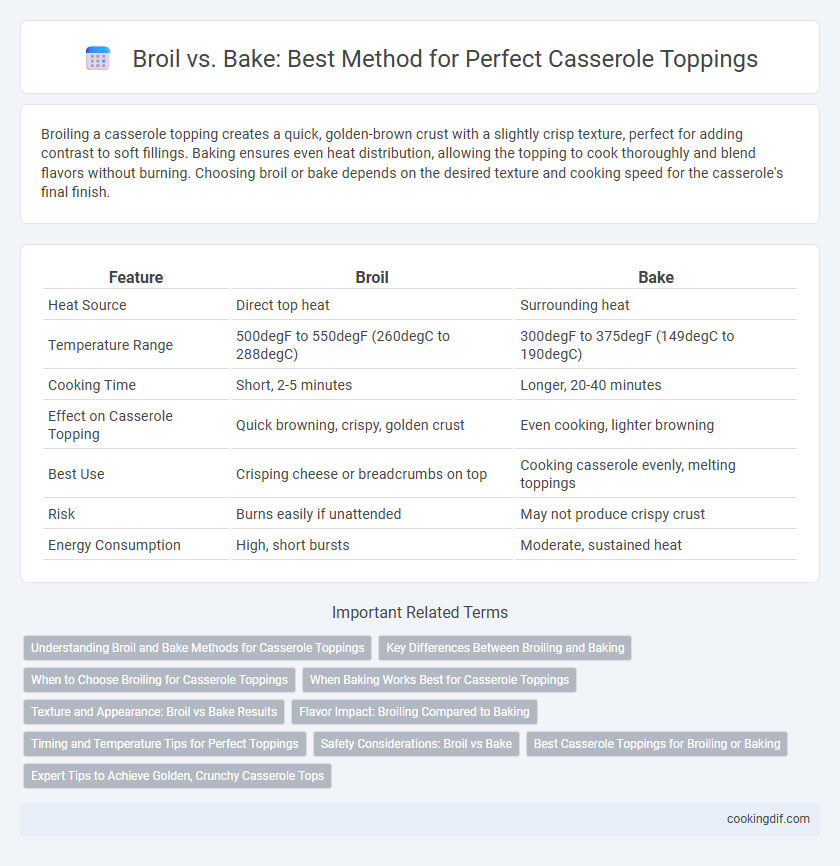Broiling a casserole topping creates a quick, golden-brown crust with a slightly crisp texture, perfect for adding contrast to soft fillings. Baking ensures even heat distribution, allowing the topping to cook thoroughly and blend flavors without burning. Choosing broil or bake depends on the desired texture and cooking speed for the casserole's final finish.
Table of Comparison
| Feature | Broil | Bake |
|---|---|---|
| Heat Source | Direct top heat | Surrounding heat |
| Temperature Range | 500degF to 550degF (260degC to 288degC) | 300degF to 375degF (149degC to 190degC) |
| Cooking Time | Short, 2-5 minutes | Longer, 20-40 minutes |
| Effect on Casserole Topping | Quick browning, crispy, golden crust | Even cooking, lighter browning |
| Best Use | Crisping cheese or breadcrumbs on top | Cooking casserole evenly, melting toppings |
| Risk | Burns easily if unattended | May not produce crispy crust |
| Energy Consumption | High, short bursts | Moderate, sustained heat |
Understanding Broil and Bake Methods for Casserole Toppings
Broiling uses intense, direct heat from above, creating a crisp, golden-brown topping quickly, ideal for melting cheese or browning breadcrumbs on casseroles. Baking surrounds the casserole with steady, even heat, allowing toppings to cook gently and meld flavors without burning. Choosing broil versus bake affects texture and appearance, with broil offering a rapid, radiant heat and bake providing thorough, even cooking crucial for casserole toppings.
Key Differences Between Broiling and Baking
Broiling exposes the casserole topping to intense direct heat from above, creating a crispy, browned crust quickly, while baking uses indirect, even heat surrounding the dish for thorough cooking. Broiling typically occurs at higher temperatures for a short duration, ideal for finishing touches, whereas baking cooks the casserole throughout at a consistent, moderate temperature. Understanding these key differences ensures the perfect texture and doneness of casserole toppings.
When to Choose Broiling for Casserole Toppings
Broiling is ideal for casserole toppings when you want to achieve a golden-brown, crispy crust quickly without overcooking the entire dish. Use the broil setting during the last few minutes of baking to melt cheese or brown breadcrumbs evenly. Monitoring closely prevents burning and ensures a perfect, crunchy finish that enhances texture and flavor.
When Baking Works Best for Casserole Toppings
Baking works best for casserole toppings when a slow, even heat is needed to melt cheese thoroughly and allow breadcrumbs to toast gently without burning. This method ensures a golden, crispy crust that enhances texture while preserving moisture in the casserole beneath. Baking temperatures around 350degF to 375degF are ideal for achieving consistent browning and an evenly cooked topping.
Texture and Appearance: Broil vs Bake Results
Broiling a casserole topping creates a crisp, golden-brown crust with a slightly charred texture that enhances visual appeal and adds a crunchy contrast to creamy fillings. Baking yields a more evenly cooked topping with a softer, golden surface that melds with the casserole without the intense browning or crispness of broiling. For a combination of texture and appearance, broiling is ideal for a finishing touch, while baking ensures thorough cooking and a uniform, lightly browned topping.
Flavor Impact: Broiling Compared to Baking
Broiling a casserole topping intensifies flavors by rapidly caramelizing sugars and browning proteins, creating a richer, more complex taste compared to baking. Baking heats the dish evenly but typically results in a milder flavor profile and softer texture on the topping. Broiling enhances crispiness and depth of flavor, making it ideal for finishing casseroles with golden, flavorful crusts.
Timing and Temperature Tips for Perfect Toppings
Broiling casserole toppings requires high heat, typically around 500degF, for 2-5 minutes to achieve a golden, crispy finish quickly without overcooking the interior. Baking at 350degF to 375degF for 20-30 minutes allows even cooking and melting of cheese or breadcrumbs, ideal for thicker casseroles. To prevent burning, broil toppings near the end of baking time, monitoring closely to ensure perfect browning and texture.
Safety Considerations: Broil vs Bake
Broiling a casserole topping exposes food to intense, direct heat, which can create a crispy, browned crust quickly but requires careful monitoring to prevent burning or smoke hazards. Baking uses lower, indirect heat that cooks the topping evenly over time, reducing fire risk and ensuring safe handling during longer cooking periods. Proper use of oven-safe dishes and maintaining appropriate distance between the food and heating element are crucial safety considerations when choosing broil or bake for casserole toppings.
Best Casserole Toppings for Broiling or Baking
Broiling a casserole topping creates a quick, golden-brown crust ideal for breadcrumbs, cheese, or crushed nuts, enhancing texture and flavor. Baking offers even heat distribution, perfect for toppings like mashed potatoes or cream-based mixtures that benefit from gentle cooking and browning. Choosing the best casserole topping depends on desired texture--broil crunchy finishes and bake creamy, cohesive layers.
Expert Tips to Achieve Golden, Crunchy Casserole Tops
Broiling casserole toppings provides high direct heat, creating a golden, crunchy crust quickly without overcooking the interior, ideal for final finishing touches. Baking offers even, gentle heat that thoroughly cooks the entire casserole, but may result in a softer topping unless extended cooking time is used. Expert chefs recommend baking casseroles until nearly done, then switching to broil for 2-5 minutes to achieve a perfectly crisp, golden top.
Broil vs Bake for casserole topping Infographic

 cookingdif.com
cookingdif.com